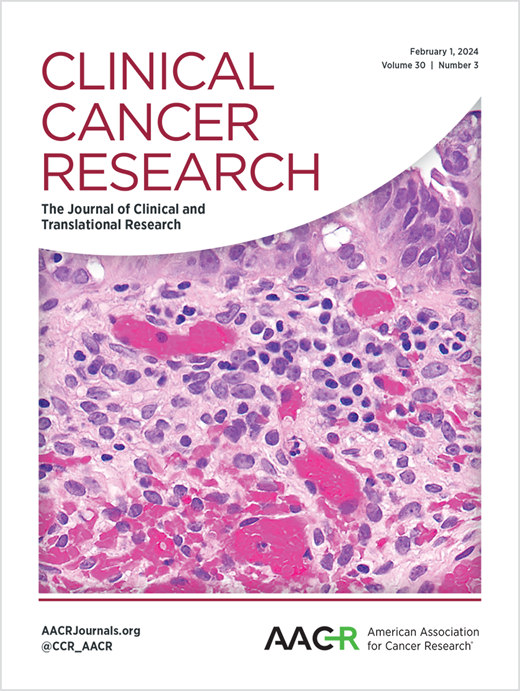ATR抑制剂Berzosertib作为单药用于四组分子定义的晚期实体瘤的转化研究
IF 10
1区 医学
Q1 ONCOLOGY
引用次数: 0
摘要
背景:临床前研究发现了ATR抑制剂敏感性的分子相关性。本转化研究旨在测试 ATR 抑制剂 berzosertib 在携带 ATRX、ATM、复制压力(RS)基因或 SDH 基因改变的晚期实体瘤患者中的疗效。研究方法招募患者组成 4 个队列:T1:T2:ATM 突变的实体瘤;T3:RS 相关基因突变的实体瘤;T4:SDH 缺失的 GIST:SDH缺陷型GIST。患者接受伯唑塞替240毫克/平方米静脉注射治疗,每周两次。在T1-T3组中获取治疗前和治疗中的活组织切片。治疗结果SDH突变型GIST患者的中位无进展生存期(PFS)最长(229天),病情稳定是最佳反应。其他组群的患者在 4 个月内病情进展。与ATM或RS基因突变/未发生突变的患者相比,PFS没有明显差异。治疗期间活组织检查中pS345-CHK1的降低表明伯唑赛替布具有靶向作用,同时部分患者的DNA损伤(g-H2AX)和RS(pKAP1)标志物水平也有大幅提高。然而,这些生物标志物的变化并没有转化为临床获益。相反,在T1-T3组中,治疗过程中SFLN11表达的增加与临床获益相关(HR = 0.045; 95%CI 0.005-0.400)。结论在所有队列中,只有SDH突变GIST患者的疾病控制时间延长。尽管有证据表明存在靶点参与,但所有其他队列的入组患者的PFS都很短,这表明患者对ATR抑制剂单药治疗的适应很快。在这些患者中,伯唑色替布暴露期间肿瘤表达SLFN11的患者临床获益最多。本文章由计算机程序翻译,如有差异,请以英文原文为准。
A Translational Study of the ATR Inhibitor Berzosertib as Monotherapy in Four Molecularly Defined Cohorts of Advanced Solid Tumors
Background: Preclinical studies have identified molecular correlates of sensitivity to ATR inhibition. This translational study was designed to test the ATR inhibitor berzosertib in patients with advanced solid tumors carrying alterations in ATRX, ATM, genes conferring replication stress (RS), or SDH. Methods: Patients were recruited to 4 cohorts: T1: ATRX-mutant leiomyosarcoma; T2: ATM-mutant solid tumors; T3: solid tumors with mutations in RS-associated genes; and T4: SDH-deficient GIST. Patients were treated with berzosertib 240 mg/m2 IV twice per week. Pre and on-treatment biopsies were obtained in cohorts T1-T3. Results: Patients with SDH-mutant GIST had the longest median progression-free survival (PFS) (229 days) with stable disease as the best response. Patients in the other cohorts experienced progressive disease within 4 months. There was no significant difference in PFS comparing outcomes in patients with/without mutations in ATM or RS genes. Decreased pS345-CHK1 in on-treatment biopsies indicated target engagement by berzosertib and were accompanied by substantial increases in levels of DNA damage (g-H2AX) and RS (pKAP1) markers in a subset of patients. However, these biomarker changes did not translate to clinical benefit. In contrast, in cohorts T1-T3, increased expression of SFLN11 on treatment correlated with clinical benefit (HR = 0.045; 95%CI 0.005-0.400). Conclusions: Across cohorts, only SDH-mutant GIST patients experienced prolonged disease control. Despite evidence of target engagement, patients enrolled to all other cohorts had short PFS, suggesting rapid adaptation to ATR inhibitor monotherapy. Among these patients, those with tumors expressing SLFN11 during berzosertib exposure derived the most clinical benefit.
求助全文
通过发布文献求助,成功后即可免费获取论文全文。
去求助
来源期刊

Clinical Cancer Research
医学-肿瘤学
CiteScore
20.10
自引率
1.70%
发文量
1207
审稿时长
2.1 months
期刊介绍:
Clinical Cancer Research is a journal focusing on groundbreaking research in cancer, specifically in the areas where the laboratory and the clinic intersect. Our primary interest lies in clinical trials that investigate novel treatments, accompanied by research on pharmacology, molecular alterations, and biomarkers that can predict response or resistance to these treatments. Furthermore, we prioritize laboratory and animal studies that explore new drugs and targeted agents with the potential to advance to clinical trials. We also encourage research on targetable mechanisms of cancer development, progression, and metastasis.
 求助内容:
求助内容: 应助结果提醒方式:
应助结果提醒方式:


